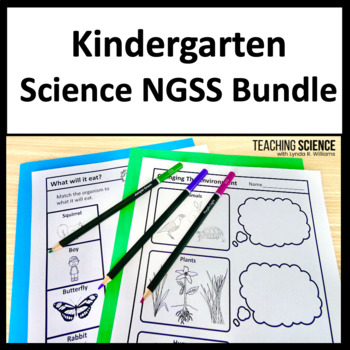NGSS Kindergarten Year Long Kindergarten Science Lesson & Science Activities
- Zip
Products in this Bundle (13)
showing 1-5 of 13 products
Bonus
Description
This Kindergarten Science Bundle addresses all NGSS standards for Kindergarten science and covers a whole year of instruction. Save 20% on Kindergarten Science by purchasing these resources together. Students will love these engaging science activities! ❤️❤️❤️
Includes:
- hands-on activities
- science centers
- lesson plans
- worksheets
- slide shows
- answer keys
- Labs use easy-to-gather household materials.
- Includes a suggested schedule
- resource alignment with standards
Perfect for a kindergarten teacher who wants to have the whole year of integrated science instruction organized in easy-to-use units.
Garrison ⭐️ ⭐️ ⭐️ ⭐️ ⭐️ Extremely Satisfied
This is a good resource that covers many science themes. I use this to plan my science themes and lesson and then supplement with free resources or things I create myself.
These units are included:
Living Things and What They Need
Weather Activities for Kindergarten
Taking Care of the Environment
All About Chickens Kindergarten
Center for Life Cycle of a Butterfly
Life Cycle of a Butterfly Smoosh Book
K-PS2 Motion and Stability: Forces and Interactions
K-PS2-1. Plan and conduct an investigation to compare the effects of different strengths or different directions of pushes and pulls on the motion of an object. [Clarification Statement: Examples of pushes or pulls could include a string attached to an object being pulled, a person pushing an object, a person stopping a rolling ball, and two objects colliding and pushing on each other.] [Assessment Boundary: Assessment is limited to different relative strengths or different directions, but not both at the same time. Assessment does not include non-contact pushes or pulls such as those produced by magnets.] K-PS2-2. Analyze data to determine if a design solution works as intended to change the speed or direction of an object with a push or a pull.* [Clarification Statement: Examples of problems requiring a solution could include having a marble or other object move a certain distance, follow a particular path, and knock down other objects. Examples of solutions could include tools such as a ramp to increase the speed of the object and a structure that would cause an object such as a marble or ball to turn.] [Assessment Boundary: Assessment does not include friction as a mechanism for change in speed.]
K-PS3 Energy
K-PS3-1. Make observations to determine the effect of sunlight on Earth’s surface. [Clarification Statement: Examples of Earth’s surface could include sand, soil, rocks, and water] [Assessment Boundary: Assessment of temperature is limited to relative measures such as warmer/cooler.]
K-PS3-2. Use tools and materials to design and build a structure that will reduce the warming effect of sunlight
K-LS1 From Molecules to Organisms: Structures and Processes
K-LS1-1. Use observations to describe patterns of what plants and animals (including humans) need to survive.
K-ESS2 Earth’s Systems
K-ESS2-1. Use and share observations of local weather conditions to describe patterns over time. [Clarification Statement: Examples of qualitative observations could include descriptions of the weather (such as sunny, cloudy, rainy, and warm); examples of quantitative observations could include numbers of sunny, windy, and rainy days in a month. Examples of patterns could include that it is usually cooler in the morning than in the afternoon and the number of sunny days versus cloudy days in different months.] [Assessment Boundary: Assessment of quantitative observations limited to whole numbers and relative measures such as warmer/cooler.]
K-ESS2-2. Construct an argument supported by evidence for how plants and animals (including humans) can change the environment to meet their needs. [Clarification Statement: Examples of plants and animals changing their environment could include a squirrel digs in the ground to hide its food and tree roots can break concrete.]
K-ESS3 Earth and Human Activity
K-ESS3-1. Use a model to represent the relationship between the needs of different plants or animals (including humans) and the places they live. [Clarification Statement: Examples of relationships could include that deer eat buds and leaves, therefore, they usually live in forested areas; and, grasses need sunlight so they often grow in meadows. Plants, animals, and their surroundings make up a system.] K-ESS3-2. Ask questions to obtain information about the purpose of weather forecasting to prepare for, and respond to, severe weather.* [Clarification Statement: Emphasis is on local forms of severe weather.]
K-ESS3-3. Communicate solutions that will reduce the impact of humans on the land, water, air, and/or other living things in the local environment.* [Clarification Statement: Examples of human impact on the land could include cutting trees to produce paper and using resources to produce bottles. Examples of solutions could include reusing paper and recycling cans and bottles.]
K-2-ETS1 Engineering Design
K-2-ETS1-1 Ask questions, make observations, and gather information about a situation people want to change to define a simple problem that can be solved through the development of a new or improved object or tool.
K-2-ETS1-2. Develop a simple sketch, drawing, or physical model to illustrate how the shape of an object helps it function as needed to solve a given problem.
K-2-ETS1-3. Analyze data from tests of two objects.
These resources are created by Lynda R. Williams at Teaching Science
Follow me and get news of my new resources. Each new resource is discounted by 50% for the first 24 hours!
If you have questions about my resources please contact me at lywilliams1@gmail.com
* My resources are secure and not editable for copyright reasons.
Please see other bundles for NGSS. I have bundles for all the grade levels.





